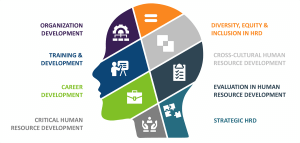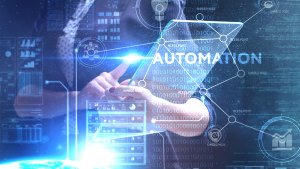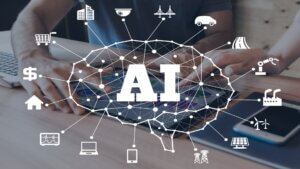Artificial intelligence (AI) has redefined the way we imagine the future. Let’s be honest: we certainly didn’t expect scenarios from the sci-fi movies, where robots and chatbots do all the work instead of humans, to happen so soon. But AI is here, and all we have to do is adjust. More and more companies that want to stay ahead and tap into new revenue channels are looking for AI software development services.
AI has become a game-changer in software development, accelerating coding and testing and automating repetitive tasks. Software engineers need not worry—AI has not reached the level where it can replace humans entirely. But it can significantly assist developers with creating high-quality products. Let’s see how!
What does AI bring to the table?
According to forecasts, the worldwide AI market is expected to reach $407 billion by 2027, a compelling sign to implement AI into your business.
At the core of AI lies the concept of imitating the human mind and its decision-making and problem-solving abilities. These two characteristics are essential in software development, where developers strive for smooth, bug-free products.
By leveraging intelligent algorithms and machine learning techniques, AI-powered tools can accurately identify the root cause of a problem and provide quick and effective solutions.
Here is a breakdown of all the benefits of AI technologies in software development that directly influence troubleshooting processes:
Quality assurance — Artificial intelligence can conduct tests, thereby reducing the chances of human errors and inconsistencies. It can also identify potential weak spots in performance and security. Using AI for quality assurance allows faster response to critical issues, minimizes downtime, and reduces troubleshooting time.
Debugging — The debugging stage has always been time-consuming for software engineers. With AI-powered tools, developers can detect which parts of code are more inclined to have errors and keep track of them. Not only that, AI can also offer the most optimal solutions for fixing them.
Code translation — AI-powered code translation tools simplify converting code between different programming languages. These tools can learn the syntax and structure of multiple programming languages, allowing developers to work with the language they’re most comfortable with by automatically translating code snippets.
Code improvement — AI technologies can simplify and enhance code quality. By analysing codebases and automating routine code reviews, artificial intelligence can assist developers in identifying vulnerabilities in their code more efficiently and accurately than traditional manual methods. It allows for quicker bug fixes and overall improvement in code quality. Artificial intelligence is also helpful for code refactoring — changing its structure without influencing its external behaviour.
Predictive analysis — Artificial intelligence is an excellent risk-management tool because it can analyse vast amounts of data. It can calculate the resources and time needed for specific projects and identify which issues will arise in the future.
AI-powered tools that can come in handy
If the previous factors piqued your interest and you are now looking for ways to implement AI into your workflow, here is a comprehensive list of tools to help you. With these applications, your product will reach new heights in quality and user experience:
- Cody AI is an AI-powered coding assistant that can answer all your questions about the codebase by thoroughly examining your existing code, documentation, and code graph. It can also assist you with debugging.
- Codium AI is a testing assistant that suggests testing while you code. It can give you valuable insights into your code and test ideas.
- Bugasura is a powerful bug tracker with extra features like tracker links and identification of similar bug reports.
- WhatTheDiff is a code optimizer tool that simplifies the code review and helps you with code refactoring.
- Mintlify Writer assists with writing the code documentation, significantly saving software developers time.
- Tabnine is another AI-powered coding assistant that helps you write code faster and more efficiently. It is not the most up-to-date tool, but it offers secure and trustworthy solutions.
Possible complications on the way
Artificial intelligence is not perfect, so it cannot wholly replace software developers. But at the same time, if not addressed, AI imperfections can bring out some serious issues in your workflow:
Security flaws — Artificial intelligence is not immune to cyber attacks, and important data can easily get leaked. To overcome this challenge, software development companies should invest more in data security and robust encryption techniques.
Data collection — Artificial intelligence needs data to learn how to make decisions and solve the issues that arise. However, collecting and processing data can be time-consuming and expensive. One solution to address AI data collection challenges is using existing data sources. Another method is to utilize techniques like active learning, which involves selecting the most informative data samples for labelling by humans, reducing the amount of data needed.
Infrastructure modifications — Implementing artificial intelligence into workflow might require changes in the existing working platforms or even switching to something more innovative, which might be very costly. One potential solution could be to start small and gradually integrate artificial intelligence into the workflow. Additionally, exploring cost-effective AI solutions could help with the financial burden of infrastructure modifications.
Errors are possible — Artificial intelligence can make mistakes in code or debugging, which might be very detrimental to the software. Monitoring AI-powered tools and their work and constantly researching new updates in this field is necessary.
Final Note
Given the myriad benefits it offers, artificial intelligence is clearly destined to stay with software development for a very long time. With automated debugging, testing, and predictive analysis processes, software engineers can finally leave the mundane tasks behind and focus on the innovation and creative aspects of their jobs.
As we move forward, we have abundant opportunities waiting for us in software development. With the help of AI-powered technologies, developers can explore new horizons and build software that does not only satisfy but even surpasses users’ desires. If you’re a software engineer, there’s never been a better time to embrace artificial intelligence and all it offers. Jump on this AI bandwagon and become part of history!
























